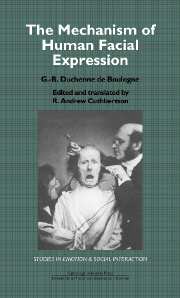Book contents
- Frontmatter
- Contents
- Acknowledgments
- Contributors
- Editor's Preface
- Part 1 The mechanism of human facial expression or an electrophysiological analysis of the expression of the emotions
- Part 2 Commentary chapters
- Chapter 1 The highly original Dr. Duchenne
- Chapter 2 The Duchenne de Boulogne Collection in The Department of Morphology, L'École Nationale Supérieure des Beaux Arts
- Chapter 3 Duchenne today: Facial expression and facial surgery
- Chapter 4 Duchenne and facial expression of emotion
- Index
Chapter 1 - The highly original Dr. Duchenne
Published online by Cambridge University Press: 10 November 2010
- Frontmatter
- Contents
- Acknowledgments
- Contributors
- Editor's Preface
- Part 1 The mechanism of human facial expression or an electrophysiological analysis of the expression of the emotions
- Part 2 Commentary chapters
- Chapter 1 The highly original Dr. Duchenne
- Chapter 2 The Duchenne de Boulogne Collection in The Department of Morphology, L'École Nationale Supérieure des Beaux Arts
- Chapter 3 Duchenne today: Facial expression and facial surgery
- Chapter 4 Duchenne and facial expression of emotion
- Index
Summary
Duchenne de Boulogne was an eccentric man with a passion for order. Disregarding his conventional professional training, he systematically catalogued the myriad manifestations of human neurological disease, using novel techniques such as electrical stimulation and photography to perform and document his experiments. When Mécanisme de la Physionomie Humaine was published by Renouard in Paris in 1862, Duchenne was already renowned for his work in neurology, experimental physiology, and medicine. This book extends his earlier investigation of skeletal muscle action into the study of the facial muscles and the mechanism of human expression. He also departs from his earlier descriptive science and enters an important contemporary debate on aesthetics: the nature of what he calls “idealized naturalism” in art. Most of what we know of Duchenne's life has been gleaned from obituaries and tributes. His publications and membership in national and international societies provide evidence of a professional success, but his private ambitions were aesthetic. Published records fail to explain his personality, his eccentricity, and his drive. It is the uneasy coexistence of the professional scientist with the amateur aesthetician that will be explored in this chapter.
A family doctor turned experimental physiologist
Duchenne's early life was conventional. Born in 1806, the son of a corsair, he attended medical school in Paris and then returned to marriage and a provincial practice on the English Channel coast in Boulogne-sur-Mer.
- Type
- Chapter
- Information
- The Mechanism of Human Facial Expression , pp. 225 - 241Publisher: Cambridge University PressPrint publication year: 1990
- 4
- Cited by



